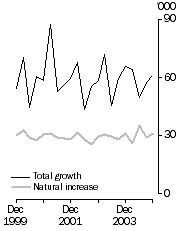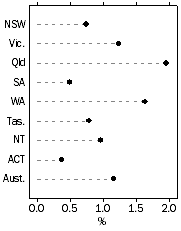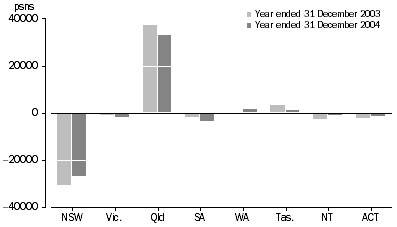DECEMBER KEY FIGURES
 | Population at end Dec qtr 2004 | Change over previous year | Change over previous year |  |
| PRELIMINARY DATA | '000 | '000 | % |  |
|  |
| New South Wales | 6,760.0 | 49.6 | 0.7 |  |
| Victoria | 5,002.3 | 60.9 | 1.2 |  |
| Queensland | 3,919.5 | 75.1 | 2.0 |  |
| South Australia | 1,537.9 | 7.5 | 0.5 |  |
| Western Australia | 1,998.4 | 32.0 | 1.6 |  |
| Tasmania | 484.0 | 3.8 | 0.8 |  |
| Northern Territory | 200.8 | 1.9 | 1.0 |  |
| Australian Capital Territory | 324.3 | 1.2 | 0.4 |  |
| Australia(a) | 20,229.8 | 232.0 | 1.2 |  |
|  |
| (a) Includes Other Territories comprising Jervis Bay Territory, Christmas Island and the Cocos (Keeling) Islands. |
Population growth

| Population growth rate, Year ended current quarter

|
DECEMBER KEY POINTS
ESTIMATED RESIDENT POPULATION
- The preliminary estimated resident population (ERP) of Australia at 31 December 2004 was 20,229,800 persons, an increase of 232,000 persons (1.2%) since 31 December 2003 and 60,900 persons since 30 September 2004.
- Preliminary natural increase during the December quarter 2004 was 31,600 persons, an increase of 0.7% on the December quarter 2003.
- Preliminary net overseas migration was 29,300 persons during the December quarter 2004, a 14.2% decrease on the December quarter 2003.
POPULATION GROWTH RATES
- The Australian population grew by 0.3% during the December quarter 2004 and 1.2% during 2004. Natural increase and net overseas migration contributed 52.7% and 47.3% respectively to Australia's total population growth during 2004.
- During the December quarter 2004 all states and territories experienced positive population growth.
- Positive population gains for all states and territories were also recorded during the 2004 calendar year. Queensland recorded the largest gain (2.0% or 75,100 persons) and the Australian Capital Territory recorded the lowest (0.4% or 1,200 persons).
NOTES
INTRODUCTION
Estimated resident population (ERP) data in this publication are based on the 2001 Census of Population and Housing. Exceptions are tables 17, 18 and 19 (excluding 2001 estimates), which are based on the 1996 Census of Population and Housing.
The Information Paper: Determining Seats in the House of Representatives - Legislative Requirements for Provision of ABS Statistics (cat. no. 3107.0.55.002) was released on 24 May 2005. This paper describes the legislative requirements of the Australian Bureau of Statistics (ABS) for producing estimates of the Commonwealth states and territories population. It also outlines the steps the ABS has taken to ensure public visibility, transparency and certainty of the population estimates that will be provided to the Electoral Commissioner for the next electoral determination, due late 2005.
REISSUE OF DATA
An error has been detected in the September quarter 2004 issue, affecting the totals published in Table 20: Estimated resident population, selected countries of birth, at 30 June. A corrected version of this table is available in this issue.
ERP DATA STATUS
At any point in time this publication contains final, revised and preliminary ERP data. The status of the ERP data included in this issue is as follows:
- Final - All ERP data up to and including June quarter 2001
- Revised - ERP data from September quarter 2001 to June quarter 2003, inclusive
- Preliminary - ERP data from September quarter 2003 to December quarter 2004, inclusive.
INTERSTATE MIGRATION DECEMBER QUARTER 2004
The Health Insurance Commission (HIC) was not able to provide the ABS with the complete number of Medicare change of address (postcode only) records required to estimate interstate migration for the December quarter 2004. Estimates for this quarter have been statistically modelled on the partial data received from HIC and past interstate migration trends. See paragraph 10 of the Explanatory Notes for more detail.
DATA NOT YET AVAILABLE
Progress is continuing with the review of annual household estimates methodology. A new methodology has been proposed and is currently being assessed. Implementation details will be made available once this assessment is complete.
INQUIRIES
For further information about these and related statistics, contact the National Information and Referral Service on 1300 135 070 or Chrissy Beruldsen on Canberra (02) 6252 5640.
MAIN FEATURES
INTRODUCTION
The preliminary estimated resident population (ERP) of Australia at 31 December 2004 was 20,229,800 persons, an increase of 60,900 (0.3%) since 30 September 2004 and 232,000 (1.2%) since 31 December 2003. This annual population growth rate (1.2%) has been consistent with the levels recorded in previous years.
COMPONENTS OF AUSTRALIA'S POPULATION CHANGE
The growth of Australia's population has two components: natural increase (the number of births minus the number of deaths) and net overseas migration (net permanent and long-term movement plus the migration adjustment).
Natural increase
Natural increase during the December quarter 2004 was 31,600 persons, an increase of 0.7% on the number recorded during the December quarter 2003. This increase is mainly due to fewer deaths (-2.1%) recorded during the December quarter 2004 compared with the December quarter 2003. The number of births registered during the December quarter 2004 was 64,300, while the number of deaths registered was 32,700.
Natural increase during 2004 was 122,300 persons, contributing 52.7% to Australia's annual population growth. Births added 254,600 babies to the population and deaths removed 132,200 persons.
The preliminary births estimates presented in this publication indicate that there has been a slight increase in the number of births over recent calendar years. However, due to the collection and estimation method applied to produce these statistics users should exercise caution when analysing and interpreting the most recent annual and quarterly births estimates, particularly when making time series comparisons. The Australian Bureau of Statistics (ABS) recommends users refer to Births, Australia (cat. no. 3301.0) for analysis of fertility trends over time. See paragraph 7 of the Explanatory Notes for more detail.
Collection and estimation of births statistics
Birth statistics produced by the ABS are based on the data provided on birth registration forms which are collected and processed by the various state and territory Registrars of Births, Deaths and Marriages. The accuracy of these estimates depends in part on the accuracy of the processing of this data as well as the information provided by parents on the registration form.
There is usually an interval between the occurrence and registration of a birth. Parents are required to submit a registration within 60 days of the child's birth, however there can be intervals of months or even years. There may also be seasonal and irregular lags in processing the forms.
Because of this issue the ABS publishes preliminary birth estimates based on quarter of registration as a proxy for quarter of occurrence. As part of the annual ERP revisions (usually released in the March quarter issue of this publication) these estimates are revised to a quarter of occurrence basis. As a result of these revisions and the differing basis of preliminary and revised births estimates, care needs to be taken when interpreting the births statistics presented in this publication. For example, when comparing 2004 calendar year births with 2003 calendar year births, estimates for March and June quarters 2003 are on a quarter of occurrence basis, whereas estimates for September quarter 2003 to December quarter 2004 are on a quarter of registration basis.
Net overseas migration
For the December quarter 2004 net overseas migration was 29,300 persons, 14.2% lower than the December quarter 2003 (34,200 persons).
For the year ended 31 December 2004 net overseas migration was 109,700 persons. During the last two years permanent arrivals and departures have recorded strong growth. Compared with five years ago the annual number of permanent arrivals and departures are up 20.9% (or 20,300 persons) and 41.1% (or 18,000 persons) respectively.
The ABS applies a number of adjustments to the overseas arrivals and departures data used to produce estimates of net overseas migration (NOM). These mainly comprise adjustments designed to reflect differences between stated travel intentions and actual travel behaviour, but (in the case of revised NOM estimates) also include adjustments to transform numbers of overseas movements into numbers of travellers. These are collectively referred to as 'migration adjustments'. For more information see the Technical Note - Measuring Net Overseas Migration.
STATES AND TERRITORIES
Population
The population of Australia's states and territories at December 2004 were as follows: New South Wales 6,760,000, Victoria 5,002,300, Queensland 3,919,500, South Australia 1,537,900, Western Australia 1,998,400, Tasmania 484,000, Northern Territory 200,800, and the Australian Capital Territory 324,300.
Victoria's population exceeded 5 million during the December quarter 2004. This milestone was achieved with the population growing by 13,400 persons (0.3%) since 30 September 2004. During 2003 and 2004, net overseas migration was the largest contributor to Victoria's population growth, closely followed by natural increase.
Consistent with the amendments to the Commonwealth Electoral Act 1918, estimates of the population of each of the Other and External Territories are listed separately in table 7 of this publication. The populations of the Other Territories continue to be included in the Australian totals presented in other tables (see paragraph 2 of the Explanatory Notes).
Growth rates
During the December quarter 2004 all states and territories recorded positive population growth. Queensland recorded the highest growth (0.5%), followed by Western Australia (0.4%), Victoria (0.3%), New South Wales, Tasmania and Northern Territory (each 0.2%), and South Australia and the Australian Capital Territory (each 0.1%).
Similarly, for the year ended 31 December 2004 all states and territories recorded positive growth rates. The highest growth was recorded by Queensland (2.0%), followed by Western Australia (1.6%), Victoria (1.2%) and the Northern Territory (1.0%). The lowest growth rate was recorded by the Australian Capital Territory (0.4%).
Interstate migration
The Health Insurance Commission (HIC) was not able to provide the ABS with the complete number of Medicare change of address (postcode only) records required to estimate interstate migration for the December quarter 2004. December quarter 2004 estimates have been statistically modelled on the partial data received from the HIC and past interstate migration trends. For further detail see paragraph 10 of the Explanatory Notes.
During the December quarter 2004 Queensland, Western Australia and Tasmania recorded net interstate migration gains, and the remaining states and territories recorded net losses.
Following the consistent trend since 2002, interstate migration was the largest contributor (43.7%) to Queensland's annual population growth during 2004 with a gain of 32,800 persons. Net gains were also recorded for Western Australia (1,900 persons) and Tasmania (1,200 persons). New South Wales lost the largest number of persons through interstate migration (-27,100 persons), followed by South Australia (-3,700 persons), Victoria (-2,100 persons), the Australian Capital Territory (-1,800 persons), and the Northern Territory (-1,200 persons).
NET INTERSTATE MIGRATION, States and territories

 Print Page
Print Page
 Print All
Print All